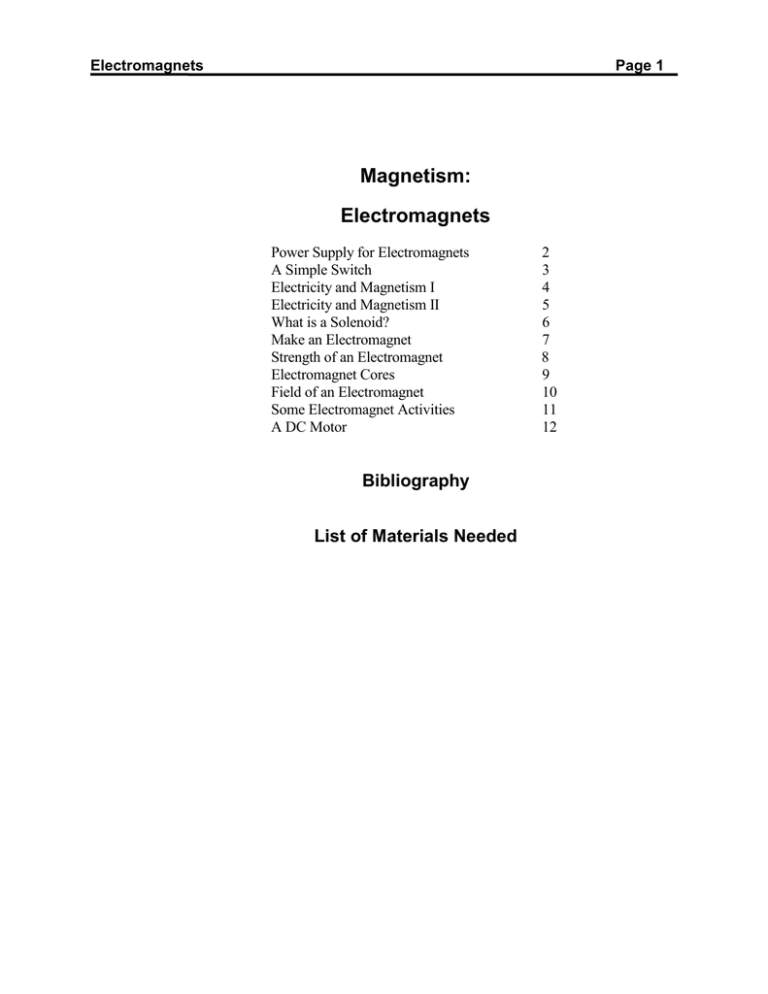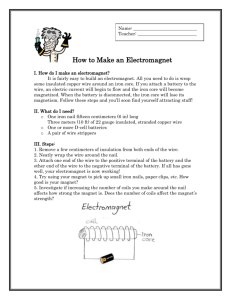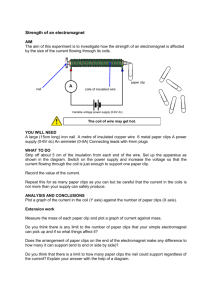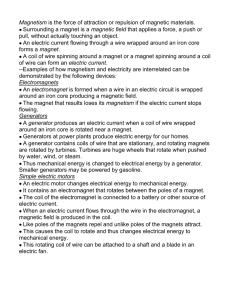Magnetism: Electromagnets
advertisement

Electromagnets Page 1 Magnetism: Electromagnets Power Supply for Electromagnets A Simple Switch Electricity and Magnetism I Electricity and Magnetism II What is a Solenoid? Make an Electromagnet Strength of an Electromagnet Electromagnet Cores Field of an Electromagnet Some Electromagnet Activities A DC Motor Bibliography List of Materials Needed 2 3 4 5 6 7 8 9 10 11 12 Electromagnets Page 2 Power Supply for Electromagnets Materials Needed: Batteries, holder, wire or aluminum foil. Concepts: Simple sources of electrical power. Activity: We are going to begin investigating electromagnets. Let's see...doesn't "electromagnets" imply magnets that are somehow "run" by electricity? That means we are going to need a source of electrical power, doesn't it? We have several options here. A battery, some wire, and some tape (duct tape works well) to hold the wire to the battery terminals is a simple option. If the wire is insulated, you will have to strip the insulation off the ends (scissors will do just fine for this). If you don't have wire, a strip of aluminum foil a foot or two long and a few inches wide, rolled into a crude "wire," will work just as well for our purposes. If you need more power, you can use the duct tape to tape two batteries together in series, with the positive end of one in contact with the negative end of the other. "D" cells will work best here. You can also buy ready-made battery holders at places like Radio Shack for a dollar or two. The small "AA" battery holders we will supply you with cost about 50 cents each. If you have to buy batteries, the "alkaline" batteries are worth the extra expense over the regular or "heavy-duty" non-alkaline batteries. They are cheaper in the long run because their longer life outweighs the greater cost. You can make a "C" cell holder out of an empty 35 mm film canister, some wires, and a couple of brads. I will show you an example. If you know anybody who uses a Polaroid or other instant-picture camera, tell them to save the used film packs for you. The film packs contain a powerful battery which will last for a long time. Questions: Have we made a dc or an ac power supply? Do you know the difference? If you don't, now is the time to ask. Why don't we worry about electrical shocks? How do we measure electrical "power"? Why might we want to connect the batteries in series? What does it mean to connect batteries in series? Some of these topics will be covered in the sessions on electricity. Special Care: Please write down any pitfalls you notice. Do any parts of this activity require special care? Be careful not to connect both ends of the power supply together for long periods of time with only a wire. That would be an electrical "short." Some consequences of a short: the battery will drain very rapidly, the wire may get very hot, and you may even burn your fingers or melt the plastic battery holder (I speak from experience, having almost burned down Mark Twain school on three separate occasions). Classroom Use: How would you use this activity in your classroom? Comments: Write down your comments on this activity. Suggested Grade Level: Show-Me Standards: Goals: 1-1, 1-2, 1-3, 1-4, 2-1, 2-2, 2-3, 3-1, 3-2, 3-3, 3-5, 3-8, 4-1, 4-6. Knowledge Standards: Math 1,6; Science 1,2,6,7; Communication Arts 1. Electromagnets Page 3 A Simple Switch Materials Needed: Wood block, paper clip, tacks or nails, wire. Concepts: How to make an electrical switch. Activity: Attach the paper clip, nails or tacks, and wire as shown in the drawing below. Press down on the paper clip to close the switch. If the paper clip gets hot due to the current flowing, hold the switch down with a pencil. If the paper clip gets really hot, stop! We don't want any fires! Special Care: Please write down any pitfalls you notice. Do any parts of this activity require special care? Classroom Use: How would you use this activity in your classroom? Comments: Write down your comments on this activity. Suggested Grade Level: Show-Me Standards: Goals: 1-1, 1-2, 1-3, 1-4, 2-1, 2-2, 2-3, 3-1, 3-2, 3-3, 3-5, 3-8, 4-1, 4-6. Knowledge Standards: Math 1,6; Science 1,2,6,7; Communication Arts 1. Electromagnets Page 4 Electricity and Magnetism I Materials Needed: Power supply, wires, compass. Concepts: Electricity and magnetism are related. Activity: Put your compass flat on the table. Which direction does the needle point? If it doesn't point north, put in top of a box or stack of books so it is far away from anything containing iron. Connect one end of one wire to the power supply and tape the wire across the compass. The wire should run parallel to the compass needle, as shown in the figure. Connect the other end of the wire to your switch, and connect another wire between the switch and battery. Close the switch. What does the compass needle do? Try to state your results as clearly and precisely as possible. z What happens if you reverse the direction of the current? z What happens if you put the wire under the compass? z Lay the wire across the compass in other orientations. What happens? z Can you explain your observations? Special Care: Please write down any pitfalls you notice. Do any parts of this activity require special care? A short length of magnet wire connected directly to both ends of a battery will heat up rapidly, run down the battery, and will burn your fingers! Don't leave the switch closed too long! Classroom Use: How would you use this activity in your classroom? Comments: Write down your comments on this activity. Suggested Grade Level: Show-Me Standards: Goals: 1-1, 1-2, 1-3, 1-4, 2-1, 2-2, 2-3, 3-1, 3-2, 3-3, 3-5, 3-8, 4-1, 4-6. Knowledge Standards: Math 1,6; Science 1,2,6,7; Communication Arts 1. Further References: Physical Science Activities for Grades 2-8. Electromagnets Page 5 Electricity and Magnetism II Materials Needed: Power supply, magnet wire, alligator clip cables, scissors, switch, index card, iron filings. Concepts: Flowing electrical current creates a magnetic field. Activity: Magnet wire is the very thin wire. Use scissors to strip the insulation off a half-inch or so of both ends of a short length of magnet wire. Attach one end of the magnet wire to an alligator clip and then to your power supply. Pour a small amount of iron filings onto an index card or microwave plate. Make a U-shaped hairpin bend in the middle of your magnet wire, dip the bend into the iron filings, and then remove it. What happens? z Now connect the other end of your wire to the power supply using another alligator clip cable and maybe a switch. Dip the bend into the iron filings and then remove it. What happens? What happens if you use a coil of wire instead of a hairpin bend? (Loop the wire 3 or 4 times around a pen and slide it off to make a coil). z Do the iron filings stay stuck on the hairpin bend after you disconnect the power? z Explain your observations. Special Care: Please write down any pitfalls you notice. Do any parts of this activity require special care? Remember not to leave the wire connected to both of the power supply terminals for very long. Your fingers or nose will tell you if you do! Classroom Use: How would you use this activity in your classroom? Comments: Write down your comments on this activity. Suggested Grade Level: Show-Me Standards: Goals: 1-1, 1-2, 1-3, 1-4, 2-1, 2-2, 2-3, 3-1, 3-2, 3-3, 3-5, 3-8, 4-1, 4-6. Knowledge Standards: Math 1,6; Science 1,2,6,7; Communication Arts 1. Further References: Physical Science Activities for Grades 2-8. Electromagnets Page 6 What is a Solenoid? Materials Needed: Power supply, magnet wire, alligator clip cables, switch, pencil, compass, scissors. Concepts: A coil of wire acts like a bar magnet. Activity: Get a couple of feet of magnet wire. Magnet wire is basically just wire with a very thin insulating coating. (Do you know why we want the insulation to be thin?) Use your scissors to strip a little insulation off each end. Wind the middle portion of the wire around the pencil in a tight coil. Remove the pencil. You have made a solenoid. z Use alligator clip cables to connect your coil in series with the power supply and a switch. You can check the continuity of your circuit with a light bulb, but you'll need to remove the light bulb during this experiment, because it has too much resistance to the flow of electrical current. Hold a compass near one end of the solenoid and close the switch. What does the compass do? Hold the compass at the other end of the solenoid and repeat. Is there any difference? What happens when you reverse the wire connections to the power supply? Special Care: Please write down any pitfalls you notice. Do any parts of this activity require special care? Classroom Use: How would you use this activity in your classroom? Comments: Write down your comments on this activity. Suggested Grade Level: Show-Me Standards: Goals: 1-1, 1-2, 1-3, 1-4, 2-1, 2-2, 2-3, 3-1, 3-2, 3-3, 3-5, 3-8, 4-1, 4-6. Knowledge Standards: Math 1,6; Science 1,2,6,7; Communication Arts 1. Further References: Safe and Simple Electrical Experiments. Electromagnets Page 7 Make an Electromagnet Materials Needed: Power supply, magnet wire, large nail, small magnetic objects (nails, paper clips, etc.) Concepts: An electromagnet is a coil of wire and a magnetic core. Activity: Take a nail. See if it picks up paper clips. If it does, demagnetize it (you remember how to do that, don't you?). Wrap a coil of magnet wire around the nail, just like you did in the What is a Solenoid activity. Try about 25 to 50 turns of wire. Connect the wire to the battery. Does the nail pick up paper clips now? What have you made? Special Care: Please write down any pitfalls you notice. Do any parts of this activity require special care? Classroom Use: How would you use this activity in your classroom? Comments: Write down your comments on this activity. Suggested Grade Level: Show-Me Standards: Goals: 1-1, 1-2, 1-3, 1-4, 2-1, 2-2, 2-3, 3-1, 3-2, 3-3, 3-5, 3-8, 4-1, 4-6. Knowledge Standards: Math 1,6; Science 1,2,6,7; Communication Arts 1. Further Investigation: Are the same kinds of materials attracted to this magnet as to our permanent magnets? Make a prediction, do some experiments, and summarize the results. Electromagnets Page 8 Strength of an Electromagnet Materials Needed: Power supply, magnet wire, nails, paper clips or other small metal objects. Concepts: Electromagnet strength depends on core material, turns of wire, and electrical current. Activity: Wrap your magnet wire around two nails, but loose enough so that you can remove one of them. Start with about 25 turns. Remove one nail. Use only 1 "D" cell of your power supply. How many paper clips (or other small objects which are attracted to magnets) can your electromagnet pick up? Re-insert the other nail. Now how many paper clips can your magnet pick up? Wind 25 more turns (for a total of 50) and see how many paper clips your two-nail magnet can pick up. Repeat some of these experiments using a 2 "D" cell power supply. Can you generalize your observations? Does the size of the nail matter? Does it matter which end of the nail you use? If so, why? Special Care: Please write down any pitfalls you notice. Do any parts of this activity require special care? The strength of the electromagnet will vary depending on the size, strength, and "freshness" of your batteries. Your students are guaranteed to wear down the batteries very quickly. Classroom Use: How would you use this activity in your classroom? Comments: Write down your comments on this activity. Suggested Grade Level: Show-Me Standards: Goals: 1-1, 1-2, 1-3, 1-4, 2-1, 2-2, 2-3, 3-1, 3-2, 3-3, 3-5, 3-8, 4-1, 4-6. Knowledge Standards: Math 1,6; Science 1,2,6,7; Communication Arts 1. Further Investigation: What would happen if you replaced your nail with a straw or pencil? Make a prediction, and then test your prediction. Electromagnets Page 9 Electromagnet Cores Materials Needed: Power supply, magnet wire, assorted objects for electromagnet cores, paper clips or other small magnetic objects. Concepts: What you put in the core of an electromagnet is important. Activity: As a "Further Investigation" in the Strength of an Electromagnet activity, you may have tried to attract paper clips to a pencil. Do you remember what happened (or can you predict what would have happened)? Now let's investigate electromagnets with different core materials and see what happens. Make electromagnets with different core materials. Try nails, pencils, transformer steel, paper clips, pins, etc. I will supply a few, and you can invent more. z Questions: what should we do about the number of batteries and number of turns of magnet wire used in this activity? Can you draw any conclusions as to what makes a good electromagnet core? Special Care: Please write down any pitfalls you notice. Do any parts of this activity require special care? Classroom Use: How would you use this activity in your classroom? Comments: Write down your comments on this activity. Suggested Grade Level: Show-Me Standards: Goals: 1-1, 1-2, 1-3, 1-4, 2-1, 2-2, 2-3, 3-1, 3-2, 3-3, 3-5, 3-8, 4-1, 4-6. Knowledge Standards: Math 1,6; Science 1,2,6,7; Communication Arts 1. Further Investigation: If you used a pencil as a core, did you magnetize the pencil itself? Electromagnets Page 10 Field of an Electromagnet Materials Needed: Electromagnet, index card or clear plastic sheet, iron filings. Concepts: Electromagnets produce magnetic fields too. Activity: By now you may realize that electromagnets produce magnetic fields rather like those of permanent magnets. Put your electromagnet flat on the table (not connected to the power supply yet) and lay an index card, piece of clear plastic flat, or microwave plate over it. Connect the magnet to the power supply, sprinkle some iron filings on the card (or whatever), and disconnect the magnet. Explain what you see. You can also investigate the electromagnet's field using your compasses. Special Care: Please write down any pitfalls you notice. Do any parts of this activity require special care? Classroom Use: How would you use this activity in your classroom? Comments: Write down your comments on this activity. Suggested Grade Level: Show-Me Standards: Goals: 1-1, 1-2, 1-3, 1-4, 2-1, 2-2, 2-3, 3-1, 3-2, 3-3, 3-5, 3-8, 4-1, 4-6. Knowledge Standards: Math 1,6; Science 1,2,6,7; Communication Arts 1. Electromagnets Page 11 Some Electromagnet Activities Materials Needed: See individual activity descriptions. Concepts: Here are some additional activities with electromagnets. Make an Electromagnet Do Work. Make a solenoid at one end of a straw. Place a nail part way inside the straw. Connect the solenoid to your power supply. What happens? What could you use this for? Magnetizing a screwdriver. Have you ever had a magnetized screwdriver? It's pretty handy, isn't it. Do you remember those nails you used in the electromagnet cores? Some of them remained magnetized after you turned the electricity off, didn't they. Hmmm...can you guess one way to magnetize a screwdriver? Unfriendly Paper Clips. Take about 3 feet of magnet wire and use a small jar an inch or so in diameter (or your fingers if you have no jar) to wind a solenoid. Leave about six inches or so of wire unwound at each end. Assemble the coil and paper clips as shown in the drawing. Connect one end of the magnet wire to the power supply. Touch the other end to the other terminal of the power supply (or else use your switch). What happens? Why? Moving Coils. Use the coils you made in the Unfriendly Paper Clips activity. Place a permanent magnet just below the coils. Connect one end of the magnet wire to the power supply and briefly touch the other end to the other terminal (or else use your switch). What does the coil do? Reverse the connections to the power supply. Does anything different happen? Can you cause the same effect by turning the magnet over? Magnetic Diver. Wind your magnet wire around the jar or vial. You may have to experiment with the number of turns required for the desired effect. Fill the jar with water beyond the wires. Cut a piece of cork or floating material and stick a nail through it so that the nail just barely floats vertically and outside the coil when you place cork+nail in the water. Can you use the power supply to make the nail-diver dive? Show-Me Standards: Goals: 1-1, 1-2, 1-3, 1-4, 2-1, 2-2, 2-3, 3-1, 3-2, 3-3, 3-5, 3-8, 4-1, 4-6. Knowledge Standards: Math 1,6; Science 1,2,6,7; Communication Arts 1. Further References: Safe and Simple Electrical Experiments. Electromagnets Page 12 A Direct Current Motor Materials Needed: Block of wood, paper clips, nails, battery, wire, nails, hammer, pliers, scissors, permanent magnet. The design I copied this from specified 1.5 meters of 24 gauge enamel insulated copper wire, but we found this activity works well with bell wire, which is easy to obtain. Concepts: Make a simple "motor." Activity: 1. Wind the wire around two fingers or a large magic marker or test tube, leaving approximately 8 cm on each end. You should have about 15 turns in your coil. Then wrap the ends through the coil two times to secure the coil. The ends of the wire should be sticking out at 180E to each other, as shown below. Bend the coil so that it is a circle. 2. Sand the enamel insulation, so you can see the copper wire on only one side of each of the ends that stick out from the coil. Be sure to sand the same side on both ends. 3. Construct a base to support your coil using paper clips, nails, wood block, magnet, and two lead wires to the battery. Adjust the paper clips so that the coil spins close to the magnet. Trial and error will eventually lead to success. 4. Be patient, it really works. If you are having trouble, begin all over. This motor was designed by Bruce Chapman of Washington High School, Washington, Missouri. Special Care: Please write down any pitfalls you notice. Do any parts of this activity require special care? Important construction notes: the wire should be thick enough that the loop doesn't sag when suspended between the paper clips. The loop of wire should be not too heavy, not too light, and should be very delicately balanced when you suspend it. You can get away with stripping the insulation from all of one side or even all of both sides and still make a working motor. A bigger loop or magnet is not necessarily better. Classroom Use: How would you use this activity in your classroom? Comments: Write down your comments on this activity. Suggested Grade Level: Show-Me Standards: Goals: 1-1, 1-2, 1-3, 1-4, 2-1, 2-2, 2-3, 3-1, 3-2, 3-3, 3-5, 3-8, 4-1, 4-6. Knowledge Standards: Math 1,6; Science 1,2,6,7; Communication Arts 1. Electromagnets Page 13 CURRICULUM K: Observe how a group of objects responds to a magnet. First: Identify the properties of magnets; identify the direction an object will move when it is pushed or pulled; draw conclusions based on observed evidence. Second: Describe how a group of objects respond to a magnet. Third: Predict the direction an object will move when it is pulled or pushed; distinguish between gravity, magnetism, and friction as types of forces. Fourth: Classify circuits as series or parallel; predict objects as being conductors or insulators of electricity. Sixth: Given a group of materials, classify them as conductors or nonconductors of electricity. BIBLIOGRAPHY Graf, Rudolf F. Safe and Simple Electrical Experiments. New York: Dover Publications, 1973. Herbert, Don, and Ruchlis, Hy. Mr. Wizard's 400 Experiments in Science. Prism Publications, 1968. Herbert, Don, and McKie, Roy. Mr. Wizard's Supermarket Science. New York: Random House, 1980. McGill, Ormond. Science Magic. New York: Prentice Hall, 1986. Tolman, Marvin N., and Morton, James O. Physical Science Activities for Grades 2-8. West Nyack, NY: Parker Publishing Co., 1986. VanCleave, Janice Pratt. Teaching the Fun of Physics. New York: Prentice Hall, 1985. Walpole, Brenda. 175 Science Experiments to Amuse and Amaze Your Friends. New York: Random House, 1988. Electromagnets Page 14 Materials Needed This page contains a list of all items listed as "materials needed" in the electromagnet activities. alligator clip cables aluminum foil assorted objects for electromagnet cores batteries battery holder blocks of wood (two) compass electromagnet hammer index cards or clear plastic sheet iron filings large nail magnet wire nails paper clip pencil permanent magnet pliers power supply scissors small magnetic objects (nails, paper clips, etc.) switch tacks or nails wires




